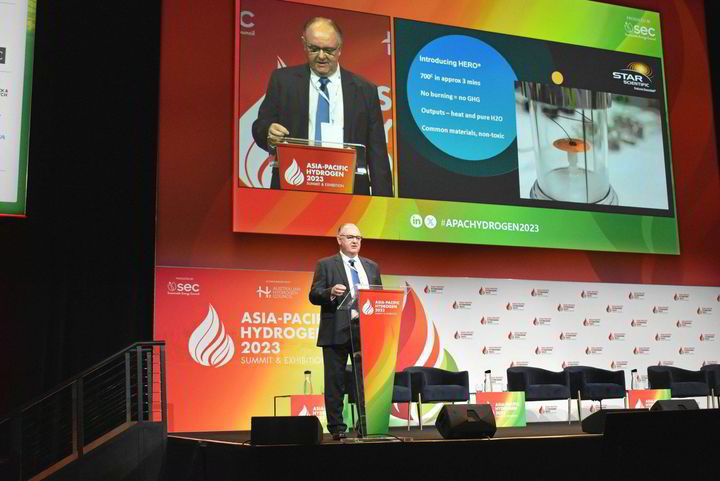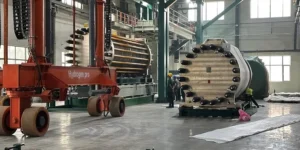‘Profound breakthrough’ | New technology generates steady high-temperature heat from hydrogen without combustion or fuel cells

Australian innovation company Star Scientific has begun commercialising a new technology that turns room-temperature hydrogen and oxygen into steady 700°C heat, with the only output being pure water.
The Hydrogen Energy Release Optimiser, known as Hero, uses a globally patented catalyst that quickly heats up in the presence of H2 and O2 and then reverts to its original state with zero degradation.
No fuel cells or combustion are involved.
The exact make-up of the catalyst is a trade secret, but Star Scientific global group chairman Andrew Hovarth told the Asia-Pacific Hydrogen Summit in Sydney today that it “is made from relatively common non-toxic elements”.
Star says the Hero technology can be used to produce steady zero-emission heat for use in multiple applications, including food production and power generation, by simply taking the green hydrogen and oxygen produced by renewables-powered electrolysers.
And the pure water that emerges from the process can be used as the feedstock for the electrolysers.
Article continues below the advert
Only tiny amounts of electricity are required by the Hero technology to power switches, pumps and gauges.
While green electricity could be used directly to produce similar temperatures in industry, fluctuations in variable wind and solar power make it hard for businesses to produce the steady green heat they need — which is often 24 hours a day, 365 days a year — according to Star.
“About five years ago, as part of our materials research, we developed a profound breakthrough, an award-winning catalyst called the hydrogen energy release optimiser, or Hero,” Horvath told delegates. “It chemically oxidises hydrogen and oxygen into high levels of heat very quickly, without any other output other than pure water.”
“In controlled experiments… we’re at 700°C in under three minutes.”
Horvath described Hero as “the missing link in the hydrogen supply chain”.
“We’ve noted the assumptions in countless reports and conferences like this one that the demand side, how to use hydrogen, is fuel cells and burning hydrogen.
“However, as our network of potential customers continually tell us, both have great limitations. And this is where Hero fits in.
“It can extract the energy from the chemistry of hydrogen without generating greenhouse gases and without the engineering complexities of burning hydrogen.”
Pilot projects are now under way on the Central Coast of New South Wales, close to Star’s headquarters, where food giant Mars and packaging company TrendPac are running pilot schemes using Hero equipment.
The technology could also be used to generate large-scale power.
“We don’t believe you should burn hydrogen to liberate its energy,” Horvath explained. “You don’t have to dig too far to find public statements from turbine manufacturers about the engineering problems of burning hydrogen.
“Aside from the engineering and efficiency issues related to hydrogen turbines, there are issues with their water use.”
He continued: “We have a bit of an unreal situation where premiers and ministers are making promises about hydrogen-derived energy, while the technology providers, when you sit and talk with them, are at best ambiguous about their capacity to meet the stipulated timeframes.
“The good news is there is an alternate way to decant energy from hydrogen for large-scale energy generation without burning it. This involves the mating of Hero to a new generation of supercritical CO2 turbines. These avoid the downfall of combined cycle turbines. SCO2 is a proven technology. No greenhouse gases need to be vented. The systems are air-cooled, avoiding massive water needs that the wet cycle combustion turbines require.
“To top it off, they’re about one-tenth the size of the equivalent steam turbine, and therefore easily transportable and deployable.”
Steve Heaton, global head of research at Star Scientific, explained in a separate presentation that the size of the catalyst will determine the amount of heat generated.
“Our catalyst surface gets hot. You want more heat, you make more surface, more catalytic surface. That then conductively transfers the heat into whatever working medium you want. That could be water if you want to produce steam, it might be a silicon oil if you’re going to run an organic Rankine cycle turbine.”
Heaton explained that boilers in coal-fired power stations could simply be replaced by Hero technology to produce the same amount of steam, which turns turbines to produce power, thus maintaining all of the infrastructure while replacing a dirty fossil fuel with clean energy.
“Keep the turbine, get rid of the polluting stuff,” he stated, although he did point out that a 2.88GW coal power plant would require vast amounts of hydrogen to produce the same amount of energy — 5,400 tonnes per day.
“So perhaps one of the most exciting opportunities though, is for supercritical CO2.”
But Star Scientific sees its primary customers, at least in the short term, in the food sector.
Deputy CEO and head of business development Matthew Hingerty explained: “The food industry uses a lot of gas for heating boilers, for heating water, for making steam, for drying materials. Think of the dairy sector. If you want to send powdered milk to China, well, you’ve got to dry your milk. In New Zealand, they’ve been using coal-fired boilers to do so.
“Brewers — we’ve had the two biggest brewing corporations in the world through our factory. They all want to replace carbon from their scope on emissions. Why? The smart ones are seeing carbon borders, carbon tariffs going up around the world. Yes, at the moment it’s for steel, it’s for chemicals, but they think it won’t be too long before there is a potential of carbon tariffs on foodstuffs that are exported.
“They also think that consumers will begin to boycott carbon-intensive products… or the supermarket chains will [eventually] say, ‘no, we’re not going to stock your stuff anymore, it’s too carbon-intensive.
“The smart companies are getting ahead of the curve.”





